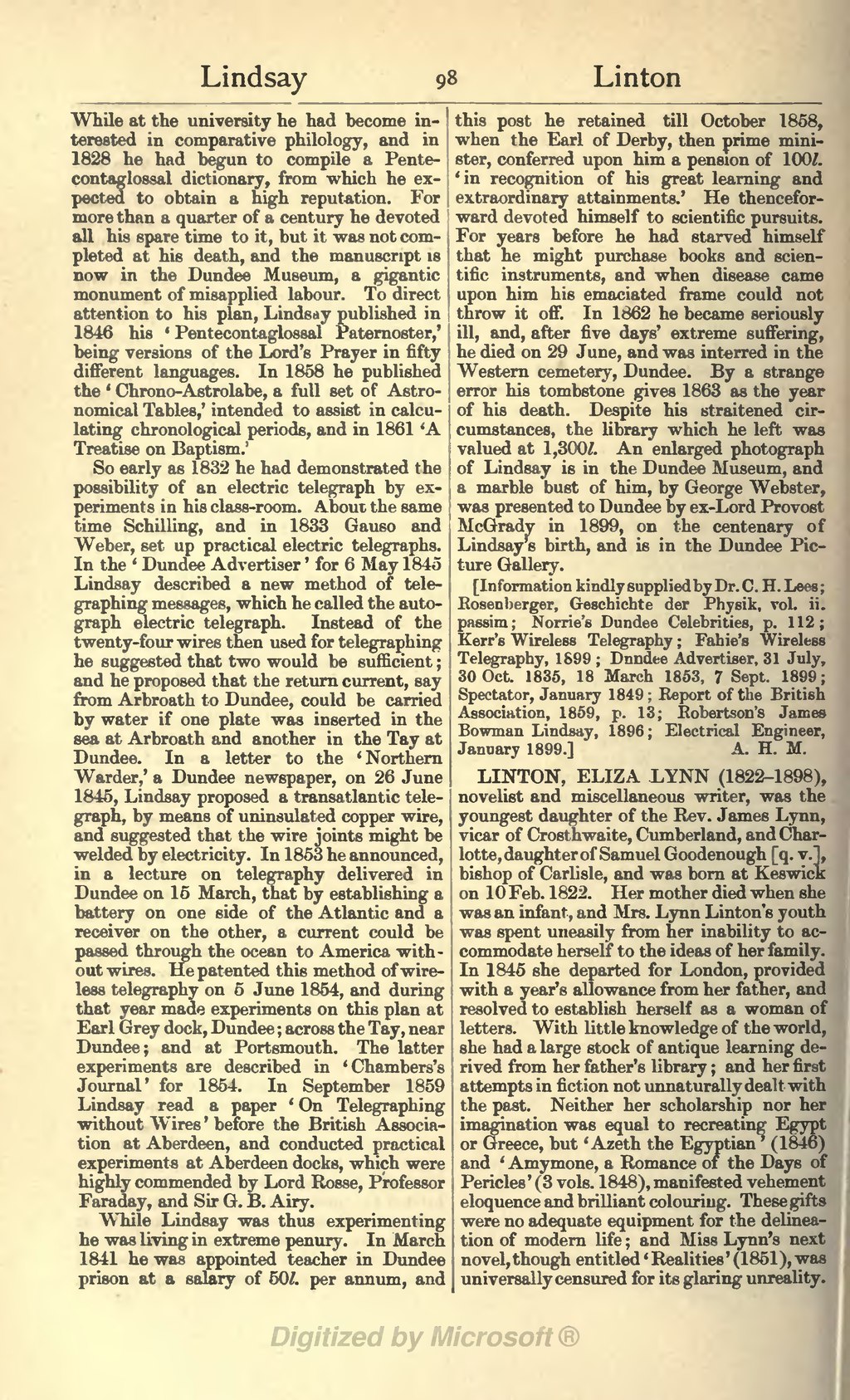While at the university he had become interested in comparative philology, and in 1828 he had begun to compile a Pentecontaglossal dictionary, from which he expected to obtain a high reputation. For more than a quarter of a century he devoted all his spare time to it, but it was not completed at his death, and the manuscript is now in the Dundee Museum, a gigantic monument of misapplied labour. To direct attention to his plan, Lindsay published in 1846 his 'Pentecontaglossal Paternoster,' being versions of the Lord's Prayer in fifty different languages. In 1858 he published the 'Chrono-Astrolabe, a full set of Astronomical Tables,' intended to assist in calculating chronological periods, and in 1861 'A Treatise on Baptism.'
So early as 1832 he had demonstrated the possibility of an electric telegraph by experiments in his class-room. About the same time Schilling, and in 1833 Gauso and Weber, set up practical electric telegraphs. In the 'Dundee Advertiser' for 6 May 1845 Lindsay described a new method of telegraphing messages, which he called the autograph electric telegraph. Instead of the twenty-four wires then used for telegraphing he suggested that two would be sufficient; and he proposed that the return current, say from Arbroath to Dundee, could be carried by water if one plate was inserted in the sea at Arbroath and another in the Tay at Dundee. In a letter to the 'Northern Warder,' a Dundee newspaper, on 26 June 1845, Lindsay proposed a transatlantic telegraph, by means of uninsulated copper wire, and suggested that the wire joints might be welded by electricity. In 1853 he announced, in a lecture on telegraphy delivered in Dundee on 15 March, that by establishing a battery on one side of the Atlantic and a receiver on the other, a current could be passed through the ocean to America without wires. He patented this method of wireless telegraphy on 5 June 1854, and during that year made experiments on this plan at Earl Grey dock, Dundee; across the Tay, near Dundee; and at Portsmouth. The latter experiments are described in 'Chambers's Journal' for 1854. In September 1859 Lindsay read a paper 'On Telegraphing without Wires' before the British Association at Aberdeen, and conducted practical experiments at Aberdeen docks, which were highly commended by Lord Rosse, Professor Faraday, and Sir G. B. Airy.
While Lindsay was thus experimenting he was living in extreme penury. In March 1841 he was appointed teacher in Dundee prison at a salary of 50l. per annum, and this post he retained till October 1858, when the Earl of Derby, then prime minister, conferred upon him a pension of 100l. 'in recognition of his great learning and extraordinary attainments.' He thenceforward devoted himself to scientific pursuits. For years before he had starved himself that he might purchase books and scientific instruments, and when disease came upon him his emaciated frame could not throw it off. In 1862 he became seriously ill, and, after five days' extreme suffering, he died on 29 June, and was interred in the Western cemetery, Dundee. By a strange error his tombstone gives 1863 as the year of his death. Despite his straitened circumstances, the library which he left was valued at 1,300l. A An enlarged photograph of Lindsay is in the Dundee Museum, and a marble bust of him, by George Webster, was presented to Dundee by ex-Lord Provost McGrady in 1899, on the centenary of Lindsay's birth, and is in the Dundee Picture Gallery.
[Information kindly supplied by Dr. C. H. Lees; Rosenberger, Geschichte der Physik, vol. ii. passim; Norrie's Dundee Celebrities, p. 112; Kerr's Wireless Telegraphy; Fahie's Wireless Telegraphy, 1899; Dundee Advertiser, 31 July, 30 Oct. 1835, 18 March 1853, 7 Sept. 1899; Spectator, January 1849; Report of the British Association, 1859, p. 13; Robertson's James Bowman Lindsay, 1896; Electrical Engineer, January 1899.]
LINTON, ELIZA LYNN (1822–1898), novelist and miscellaneous writer, was the youngest daughter of the Rev. James Lynn, vicar of Crosthwaite, Cumberland, and Charlotte, daughter of Samuel Goodenough [q. v.], bishop of Carlisle, and was born at Keswick on 10 Feb. 1822. Her mother died when she was an infant, and Mrs. Lynn Linton's youth was spent uneasily from her inability to accommodate herself to the ideas of her family. In 1845 she departed for London, provided with a year's allowance from her father, and resolved to establish herself as a woman of letters. With little knowledge of the world, she had a large stock of antique learning derived from her father's library; and her first attempts in fiction not unnaturally dealt with the past. Neither her scholarship nor her imagination was equal to recreating Egypt or Greece, but 'Azeth the Egyptian' (1846) and 'Amymone, a Romance of the Days of Pericles' (3 vols. 1848), manifested vehement eloquence and brilliant colouring. These gifts were no adequate equipment for the delineation of modern life; and Miss Lynn's next novel, though entitled 'Realities' (1851), was universally censured for its glaring unreality.
